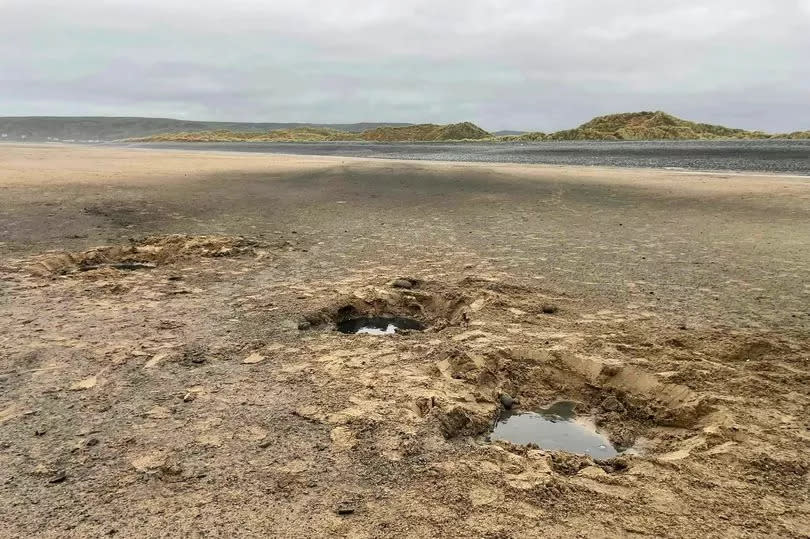Dangerous 'top secret' objects from secret military base are blown up on Welsh beach
Bomb disposal experts have conducted a string of controlled explosions at a remote Welsh beach once used for top-secret wartime trials. Beach-goers are being urged to be cautious after numerous WW11 ordnance was unearthed on a stretch of coast near Snowdonia, believed to have been exposed by a mix of extreme tides and recent bad weather.
Traeth Ynyslas, overlooking the Dyfi estuary from Gwynedd's Aberdyfi, remains a location of concern due to its history as a guided missile testing site during the Second World War. It's thought that old munitions in these areas could still pack a punch.
Among the most recent discoveries were items found by a caravan owner from neighbouring Borth, Ceredigion, while other members of the public also stumbled upon another batch. Each find prompted an immediate response from Coastguard teams who cordoned off sections of the beach around the rusting remains while they remained above water, with the Army's bomb disposal unit seeing each safely detonated. For the latest Welsh news delivered to your inbox sign up to our newsletter
READ MORE: Long-buried objects have emerged on a Welsh beach and people are being warned 'stay away'
READ MORE: 'We found set of bones on beach and brought them home - then realised they were human'
Issuing advice via their social media platforms, HM Coastguard Borth stated: "The area round Ynyslas has been used extensively in the past for munitions testing and so items of ordnance are found fairly regularly here. No matter how corroded they may seem they can potentially still contain explosive material. So, if found, please do not disturb items of potential ordnance but call 999 and report to the Coastguard."

It's far from the first time that objects of concern have been found at Ynyslas beach, now a National Nature Reserve. The nearby "hush-hush" military research base was used for experimentation on rocket propulsion systems during WW2, reports North Wales Live.
This Ministry of Supply Experimental Establishment Anti-Aircraft was the British response to Germany's long-range guided rockets, the V1 and V2, which caused havoc in London between June, 1944, and March, 1945. The war-era facility required temporary housing for army officers on location, so the HMS Camroux III, a boat outfitted with rocket launch ramps, was anchored at Aberdyfi nearby. Support award-winning journalism with WalesOnline’s Premium app on Apple or Android
The beach itself was redesigned into a target grid for practising with unrotated rocket projectiles, short-range anti-aircraft weapons developed for the Royal Navy at Winston Churchills urging. Locals were urged to keep their distance during this time.
After shutting up shop in late 1946, the facilities' testing facilities were relocated to Aberporth before eventually moving overseas. The Welsh Ancient and Historical Monuments authority (RCAHMW) only detailed the secretive establishment's purpose fully in 2012. The heritage organisation highlighted the area's historical significance with a statement: "Few visitors to the Ynyslas National Nature Reserve are aware that they have entered one of World War II's most secret research facilities, a weapons-testing range that once played a vital role in the development of rocketry, space travel, and all the associated inventions, from home insulation to heart-pacemakers, which have radically changed the world we live in today."
On March 26, beachgoers at Ynyslas were taken aback when a remnant WW11 munition was discovered and subsequently disposed of through a controlled explosion. The incident was not isolated; on April 10, several more suspicious items were found and similarly detonated by experts, leaving noticeable blast holes in the sand. In one case, live ordnance was even used as a games prop by local children.
A local man, upon seeing the images of the ordnance unearthed, issued a stark warning: "They look deceptively safe. Just rusty bits of metal. Often the case has corroded and the main explosive washed out. But they are very likely to have a small detonator fitted, which was used to set off the main explosive. That is often encased in a metal that has not corroded through with time."
"Detonators by their nature are more unstable than the main explosive. That instability tends to get worse with age. If a detonator goes off while you are handling these ordnance you could well lose your hands. Also, the shrapnel will likely make a mess of your face." Echoing the concerns of the Coastguard, he urged: "So as the Coastguard has said, please, please, report any unusual-looking objects on Ynyslas beach. Better safe than sorry."

 Yahoo News
Yahoo News 
